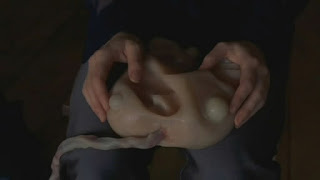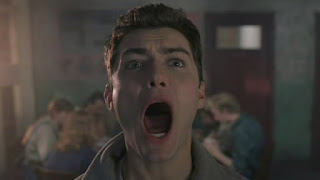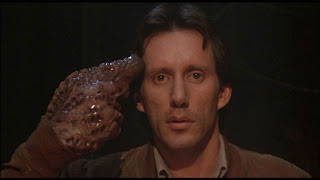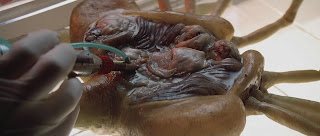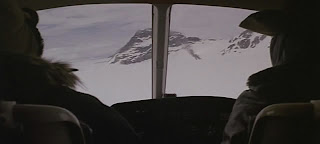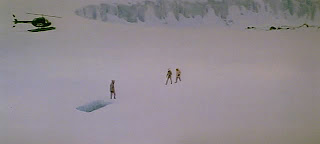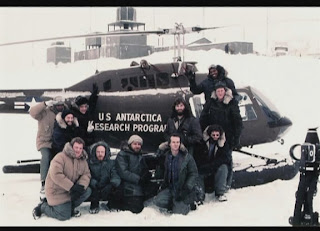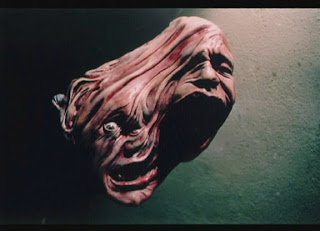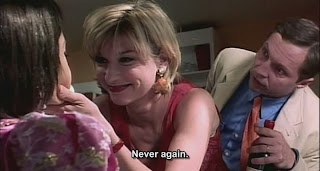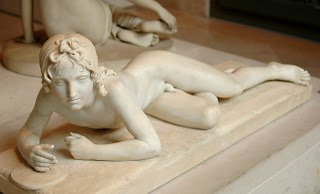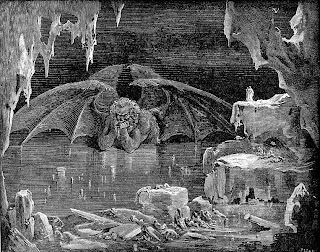 The uncanny is the vague mysterious or supernatural entity that inspires fear. Sigmund Freud, that pre-eminent psychoanalyst and cocaine addict, had trouble defining the uncanny. “It is undoubtedly related to what is frightening — to what arouses dread and horror; equally certainly, too, the word is not always used in a clearly definable sense, so that it tends to coincide with what excites fear in general.” The uncanny could include ghosts, demons, monsters, or even angels and gods. In the comic book world, the X-Men are commonly called uncanny. Czech director Jan Svankmajer’s 2000 film Little Otik combines live-action characters that we can easily identify with in normal life,
The uncanny is the vague mysterious or supernatural entity that inspires fear. Sigmund Freud, that pre-eminent psychoanalyst and cocaine addict, had trouble defining the uncanny. “It is undoubtedly related to what is frightening — to what arouses dread and horror; equally certainly, too, the word is not always used in a clearly definable sense, so that it tends to coincide with what excites fear in general.” The uncanny could include ghosts, demons, monsters, or even angels and gods. In the comic book world, the X-Men are commonly called uncanny. Czech director Jan Svankmajer’s 2000 film Little Otik combines live-action characters that we can easily identify with in normal life,  with bizarre stop-motion animated creatures. The juxtaposition of mundane-ness and horror sets us off guard.
with bizarre stop-motion animated creatures. The juxtaposition of mundane-ness and horror sets us off guard. The film tells the story of a married couple in middle class Czech Republic who are unable to conceive a child. Bozena Horakova, the housewife, suffers from idiopathic sterility (low number of eggs in the ovaries). Her husband Karel Horak, an office worker, suffers from azospermy (or azoospermia, i.e. no measurable sperm in the semen). In a possible homage, their OBGYN looks just like Freud,  complete with beard and round glasses, although fatter. In the Horak’s baby fever, many strange things occur, at least in their imagination. Karel looks out his office window and imagines he is in line to buy a baby out of a tank on the street like a fish. At home, Bozena cries into a pile of baby clothes while Karel cuts open a watermelon to find a baby inside.
complete with beard and round glasses, although fatter. In the Horak’s baby fever, many strange things occur, at least in their imagination. Karel looks out his office window and imagines he is in line to buy a baby out of a tank on the street like a fish. At home, Bozena cries into a pile of baby clothes while Karel cuts open a watermelon to find a baby inside.
During Karel’s drive home, many women with children and babies in carriages pass by his car, but a lone old hunchback  woman crosses next, a reminder of his wife’s possible fate. At their apartment building, Bozena touches Alzbetka’s (the neighbor girl) hair longingly. She is the only child in the building. Bozena and Alzbetka are both blonde; they could be related. Alzbetka is aware of the wife’s trouble conceiving and puts a ball under her shirt to imitate pregnancy. Karel and Bozena decide to buy a country house away from their apartment. While cleaning up the yard, Karel digs up a strange stump and its roots, roughly in the shape of a baby. He takes it into his shed, trims it and
woman crosses next, a reminder of his wife’s possible fate. At their apartment building, Bozena touches Alzbetka’s (the neighbor girl) hair longingly. She is the only child in the building. Bozena and Alzbetka are both blonde; they could be related. Alzbetka is aware of the wife’s trouble conceiving and puts a ball under her shirt to imitate pregnancy. Karel and Bozena decide to buy a country house away from their apartment. While cleaning up the yard, Karel digs up a strange stump and its roots, roughly in the shape of a baby. He takes it into his shed, trims it and  polishes it in a facsimile of a baby, and presents it to Bozena, half joking.
polishes it in a facsimile of a baby, and presents it to Bozena, half joking.
Bozena takes to the wood figure immediately, caring for it like a real child, changing its clothes, bathing it, and caressing it. She has had all the accoutrements of parenthood already prepared despite her sterility: baby powder, clothing, diapers, and pacifier. She becomes obsessed and perhaps a little psychotic over it. Bozena tells the neighbor she is pregnant and prepares nine pillows of  different sizes to wear under her clothing to simulate the months. She even simulates the odd diet of a pregnant woman by pigging out on pickles with whipped cream, which she then vomits up. Bozena even denies Karel sex, for fear of having a miscarriage. Karel quickly realizes he has made a mistake.
different sizes to wear under her clothing to simulate the months. She even simulates the odd diet of a pregnant woman by pigging out on pickles with whipped cream, which she then vomits up. Bozena even denies Karel sex, for fear of having a miscarriage. Karel quickly realizes he has made a mistake.
The film, based on an Eastern European fairy tale called Otesanek, becomes more bizarre as the movie progresses. The couple name their new “baby boy” Otik, and he  inexplicably comes alive. Otik, now animated in stop-motion, moves around and makes noise. He has one orifice in his head, which alternates as mouth, nose, and eye socket. Otik is also insatiably hungry, eating Bozena’s hair and anything else not nailed down. Otik grows to immense proportions because of his diet, becoming a danger to anything in his path. In the fairy tale, Otesanek eats a pot of porridge, a pail of milk, a loaf of bread, his parents, a peasant girl with her clover cart, a farmer and his hay and horse, a swineherd and his pigs, a shepherd and his flock, and Orisek the dog. Eventually an old lady with some cabbages throws a hoe into Otesanek’s stomach and it bursts. All the people tumble out, apparently no worse for wear. All of this is explained in a cartoon sequence, animated by Jan Svankmajer’s wife Eva, who unfortunately died in 2005 after 45 years of marriage.
inexplicably comes alive. Otik, now animated in stop-motion, moves around and makes noise. He has one orifice in his head, which alternates as mouth, nose, and eye socket. Otik is also insatiably hungry, eating Bozena’s hair and anything else not nailed down. Otik grows to immense proportions because of his diet, becoming a danger to anything in his path. In the fairy tale, Otesanek eats a pot of porridge, a pail of milk, a loaf of bread, his parents, a peasant girl with her clover cart, a farmer and his hay and horse, a swineherd and his pigs, a shepherd and his flock, and Orisek the dog. Eventually an old lady with some cabbages throws a hoe into Otesanek’s stomach and it bursts. All the people tumble out, apparently no worse for wear. All of this is explained in a cartoon sequence, animated by Jan Svankmajer’s wife Eva, who unfortunately died in 2005 after 45 years of marriage.
 Freud, always delving into the unconscious, was more curious about how and why the uncanny inspires fear, not what inspires it. Freud decided that the presentation of the uncanny was important, moreso than the apparition itself. “The souls in Dante's Inferno, or the supernatural apparitions in Shakespeare’s Hamlet, Macbeth or Julius Caesar, may be gloomy and terrible enough, but they are no more really uncanny than Homer’s jovial world of gods.” The animated sequences in Little Otik are presented in many different ways. The audience is always off-guard as to what they will do next. They are alternately scary, gory, and funny. At times the viewer feels uneasy about laughing during gory scenes, or dreading the upcoming horror during a funny scene.
Freud, always delving into the unconscious, was more curious about how and why the uncanny inspires fear, not what inspires it. Freud decided that the presentation of the uncanny was important, moreso than the apparition itself. “The souls in Dante's Inferno, or the supernatural apparitions in Shakespeare’s Hamlet, Macbeth or Julius Caesar, may be gloomy and terrible enough, but they are no more really uncanny than Homer’s jovial world of gods.” The animated sequences in Little Otik are presented in many different ways. The audience is always off-guard as to what they will do next. They are alternately scary, gory, and funny. At times the viewer feels uneasy about laughing during gory scenes, or dreading the upcoming horror during a funny scene.
 The live action part of the film is not as forgiving as the cartoon. The uncanny scenes ramp up with each moment, and violence is included. A hand reaches out from Mr. Zlabek’s (a dirty old man) pants to grab Alzbetka. She claims the man has tried to touch her in the past. Mr. Stadler, the Horak’s neighbor and father of Alzbetka, hallucinates that there are nails in his soup. Hilariously, the Stadler’s seem to eat nothing but soup anyway. Soon, just like the fairy tale, Otik’s hunger gets out of control. The Horak’s have to cook giant pots of milk and meat stew all
The live action part of the film is not as forgiving as the cartoon. The uncanny scenes ramp up with each moment, and violence is included. A hand reaches out from Mr. Zlabek’s (a dirty old man) pants to grab Alzbetka. She claims the man has tried to touch her in the past. Mr. Stadler, the Horak’s neighbor and father of Alzbetka, hallucinates that there are nails in his soup. Hilariously, the Stadler’s seem to eat nothing but soup anyway. Soon, just like the fairy tale, Otik’s hunger gets out of control. The Horak’s have to cook giant pots of milk and meat stew all  day, using all four burners of the stove at once. They buy huge bags of pork from the local butcher every day. Left to his own devices, Otik eats the Horak’s cat, Mikeš. Eventually he also eats Mr. Mladek the postman and a female social worker. The social worker is dispatched in fully filmed gore, with her bones and bloody tissue flying about the bedroom. We feel bad for laughing at this, because all the while Otik is making cute baby noises. Karel attempts many times to destroy Otik, but Bozena always intervenes. She has become a hysterical weakling protecting her “child” despite the carnage. She rationalizes that many people die in car accidents every year. Alzbetka, who has read the fairy tale, is the only outsider who recognizes the danger. “Here we go,” she says. “And this is only the beginning.”
day, using all four burners of the stove at once. They buy huge bags of pork from the local butcher every day. Left to his own devices, Otik eats the Horak’s cat, Mikeš. Eventually he also eats Mr. Mladek the postman and a female social worker. The social worker is dispatched in fully filmed gore, with her bones and bloody tissue flying about the bedroom. We feel bad for laughing at this, because all the while Otik is making cute baby noises. Karel attempts many times to destroy Otik, but Bozena always intervenes. She has become a hysterical weakling protecting her “child” despite the carnage. She rationalizes that many people die in car accidents every year. Alzbetka, who has read the fairy tale, is the only outsider who recognizes the danger. “Here we go,” she says. “And this is only the beginning.”
 The Horak’s lock up Otik in their building’s basement coal shed to starve (where his rumbling stomach bothers the tenants), but Alzbetka befriends him and feeds him table scraps. At this point Otik is a huge wooden monster with root arms and a giant mouth, towering over everyone. Eventually, Karel attempts to cut up Otik with Mr. Stadler’s chainsaw, but when Otik murmurs “da-da,” Karel is overcome with affection and drops his guard. He is eaten too. Apparently Bozena accepts her fate and allows herself to be eaten soon after. All of this reminds one of Little Shop of Horrors, where the protagonist Seymour adopts a carnivorous plant and brings it people to eat. The ending of Little Otik is ambiguous, but we’re left to assume the old woman in the apartment building takes her hoe to the basement and ends the madness.
The Horak’s lock up Otik in their building’s basement coal shed to starve (where his rumbling stomach bothers the tenants), but Alzbetka befriends him and feeds him table scraps. At this point Otik is a huge wooden monster with root arms and a giant mouth, towering over everyone. Eventually, Karel attempts to cut up Otik with Mr. Stadler’s chainsaw, but when Otik murmurs “da-da,” Karel is overcome with affection and drops his guard. He is eaten too. Apparently Bozena accepts her fate and allows herself to be eaten soon after. All of this reminds one of Little Shop of Horrors, where the protagonist Seymour adopts a carnivorous plant and brings it people to eat. The ending of Little Otik is ambiguous, but we’re left to assume the old woman in the apartment building takes her hoe to the basement and ends the madness.
 Freud recognized that fiction is best for the uncanny, because real life does not feature uncanny events as easily or often. “In the first place a great deal that is not uncanny in fiction would be so if it happened in real life; and in the second place that there are many more means of creating uncanny effects in fiction than there are in real life,” he said. This is the brilliance of Little Otik, because it updates a fairy tale that seems silly and harmless by putting it into real, recognizable circumstances to show us the horror that the fairy tale actually describes.
Freud recognized that fiction is best for the uncanny, because real life does not feature uncanny events as easily or often. “In the first place a great deal that is not uncanny in fiction would be so if it happened in real life; and in the second place that there are many more means of creating uncanny effects in fiction than there are in real life,” he said. This is the brilliance of Little Otik, because it updates a fairy tale that seems silly and harmless by putting it into real, recognizable circumstances to show us the horror that the fairy tale actually describes.



